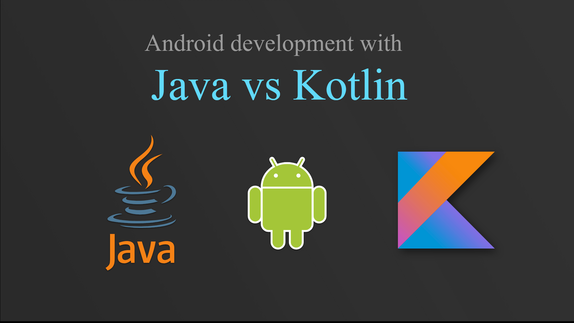Java is a programming language that has vast open-source tools and libraries to help developers. It is used by most large enterprises because of its flexibility and interoperability – and also because of it its simplicity, robustness and influential approach. Two of the major reasons why Android mobile apps are still being written in Java are because of its architectural OOP paradigm and the massiveness of the code.
Did you know?
Google’s Android operating system uses Java API packages.
A general purpose language, Kotlin is a statically typed programming language for Java Virtual Machine (JVM) and JavaScript. The goal of discovering this program was to increase its productivity and the coding experience in a way that’s practical and effective.
- Enables mixed-language projects
- Improved syntax
- Concise expressions and abstractions
- Reduces excessive boilerplate code
Java vs Kotlin
Java is a widely used programming language but it has its own drawbacks and hence, there is need for a more advanced program like Kotlin. Let’s take a look at how Kotlin can solve these issues:
Write Less Code
Java requires you to write a lengthy code which means that there is a greater chance of a bug or error to occur, whereas, Kotlin is simple and uses developer friendly coding structures and rules that are not complicated to understand.
Let’s take a look at an example of the “Hello World” program in Java and Kotlin, respectively.
Optimizing the Android Code
Technically speaking Java was discovered much before Android apps were discovered. On the other hand, Kotlin was discovered so that Android app development goes smoother, faster and is more effective.
Interoperability
A developer can write codes in Kotlin which works flawlessly with the existing Java code. The core purpose of Kotlin is interoperability – by emitting the Bytecode, it allows two languages to work together in the same project.
Checked Exception Feature
When the complier forces the caller of a function to re-throw an exception or catch one it is known as checked exceptions. This feature is not compatible with Java and cause empty checked blocks. The developers then need to weed out these empty checked boxes from the code to identify a non-existent exception. On the other hand, Kotlin removes these empty checked boxes entirely. It minimizes wordiness and improves the type-safety.
Pros and Cons of Kotlin
Pros:
- Fewer lines of code
- Easier to read and modify code which results in reduced project timelines
- Less surface area for bugs to hide and hence, locating bugs is easier for developers
- Less system failures and crashes
- Easy to learn – can easily switch from Java to Kotlin
Cons:
- Small and new community – hence, limited learning resources
- Kotlin developers are more difficult to find than Java
- Compilation might get slower compared to Java
Pros and Cons of Java
Pros:
- Can run it in a browser or virtual machine, easier to execute
- Modern tools help assemble large projects precisely
- Wide community support
- Flexibility to switch from Java to Kotlin
Cons:
- Longer code
- Takes longer to locate bugs and empty checked boxes
Final Thoughts
Kotlin 1.3 has been released with improvements such as mobile scalability – it supports invaluable benefit of code reuse, saving both, time and effort, for more challenging tasks. More and more enterprises are switching to Kotlin, some of which are Pinterest, Twitter, Netflix, Uber, AirBnB, etc.
Kotlin is in all, a more stable and appropriate development option for an Android. It is lightweight and is far less verbose. Some developers believe that Kotlin will take over Java in Android app development, whereas a few believe that they will co-exist without weighing each other out.
If you are considering to take that big step and train your developers on Kotlin or if you are simply considering if the switch from Java to Kotlin is a wise option, you can contact the App Scoop mobile app developers or App Development team on: https://app-scoop.com/contact-us.html








